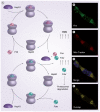Fhit tumor suppressor: guardian of the preneoplastic genome
- PMID: 19086848
- PMCID: PMC3400506
- DOI: 10.2217/14796694.4.6.815
Fhit tumor suppressor: guardian of the preneoplastic genome
Abstract
Environmental agents induce intragenic alterations in the FRA3B/FHIT chromosome fragile site, resulting in fragile FHIT allele loss early in cancer development. Fhit knockout mice are predisposed to tumor development and Fhit gene therapy reduces tumor burden. Repair-deficient cancers are likely to be Fhit-deficient and Fhit-deficient cells show enhanced resistance to ultraviolet C, mitomycin C, camptothecin and oxidative stress-induced cell killing. Loss of Fhit leads to alterations in the DNA damage response checkpoint and contributes to DNA instability. Hsp60/Hsp10 are Fhit interactors, suggesting a direct role for Fhit in stress responses. Fhit also interacts with and stabilizes ferrodoxin reductase (Fdxr), a mitochondrial flavoprotein that transfers electrons from NADPH to cytochrome P450, suggesting a role for Fhit in the modulation of reactive oxygen species production and of genomic damage.
Figures



References
-
-
Croce CM. Role of chromosome translocations in human neoplasia. Cell. 1987;49(2):155–156. ▪▪ One of the most important reviews explaining the role of chromosome translocation and how they are related to cancer initiation.
-
-
- Soloman E, Borrow J, Goddart A. Chromosome aberrations and cancer. Science. 1991;254(5035):1153–1160. - PubMed
-
-
Bartkova J, Horejsí Z, Koed K, et al. DNA damage response as a candidate anti-cancer barrier in early human tumorigenesis. Nature. 2005;434(7035):864–870. ▪▪ Reports an elegant study describing how cancer development is associated with DNA replication stress, which leads to DNA double-strand breaks, including breaks at FRA3B, checkpoint activation and selective pressure for p53 mutations.
-
-
-
Gorgoulis VG, Vassiliou LV, Karakaidos P, et al. Activation of the DNA damage checkpoint and genomic instability in human precancerous lesions. Nature. 2005;434(7035):829–830. ▪▪ Reports an elegant study describing how cancer development is associated with DNA replication stress, which leads to DNA double-strand breaks, including breaks at FRA3B, checkpoint activation and selective pressure for p53 mutations.
-
-
-
Naylor SL, Johnson BE, Minna JD, et al. Loss of heterozygosity of chromosome 3p markers in small cell lung cancer. Nature. 1987;329(6138):451–454. ▪ One of the first studies supporting the hypothesis that loss of alleles of chromosome 3p contributes to tumorigenesis in small-cell lung cancer.
-
Publication types
MeSH terms
Substances
Grants and funding
LinkOut - more resources
Full Text Sources
Research Materials
Miscellaneous
